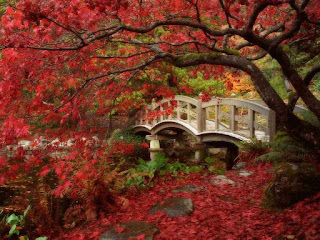Ode to autumn
(Click on the image for more poems)
Ode
to autumn is written by Keats when he felt the beauty of autumn. He saw the
fields with golden plants and grains and farmers happiness. He put the elements
of nature as the important part of the autumn. He personified creatures as farmers.
Season of
mists and mellow fruitfulness,
Close
bosom-friend of the maturing sun;
Conspiring
with him how to load and bless
With
fruit the vines that round the thatch-eves run;
To bend
with apples the moss'd cottage-trees,
And fill
all fruit with ripeness to the core;
To swell
the gourd, and plump the hazel shells
With a
sweet kernel; to set budding more,
And still
more, later flowers for the bees,
Until
they think warm days will never cease,
For
summer has o'er-brimm'd their clammy cells.
In the first stanza, poet describes the
beauty of autumn. Poet calls the season of autumn as the season of mellow
fruitfulness and the friend of maturing sun. The season is of fruitfulness because
trees get fruits in this season and flowers get blossomed. The sun is not only
sun but mature sun because it gives life to the vegetation world by its light. By
the conspiring of autumn and sun we get the most delicious fruits of the
season. Further he saw that the branches of apple trees are bend with the
weight of big ripen apples. He further imagines that when nuts will fall down
from the trees they will become seed and will become plant in another spring.
Who hath
not seen thee oft amid thy store?
Sometimes
whoever seeks abroad may find
Thee
sitting careless on a granary floor,
Thy hair
soft-lifted by the winnowing wind;
Or on a
half-reap'd furrow sound asleep,
Drows'd
with the fume of poppies, while thy hook
Spares
the next swath and all its twined flowers:
And
sometimes like a gleaner thou dost keep
Steady
thy laden head across a brook;
Or by a
cyder-press, with patient look,
Thou
watchest the last oozings hours by hours.
In the second stanza, Keats starts personification again as he asks the
question in the very first line of these stanza. He asks about the store of
autumn and its detail. Then he went on finding the autumn and the best place he
suggests is the countryside and the ‘granary’ where the harvested grains are
kept. Here the word ‘abroad’ is not about foreign country but a country side.
Where are
the songs of spring? Ay, Where are they?
Think not
of them, thou hast thy music too,—
While
barred clouds bloom the soft-dying day,
And touch
the stubble-plains with rosy hue;
Then in a
wailful choir the small gnats mourn
Among the
river sallows, borne aloft
Or
sinking as the light wind lives or dies;
And
full-grown lambs loud bleat from hilly bourn;
Hedge-crickets
sing; and now with treble soft
The
red-breast whistles from a garden-croft;
And
gathering swallows twitter in the skies.
In the third stanza, he asks that where
are the songs of spring? and he repeated the question. As per him autumn has its
own song and it has also its own importance in all four seasons. Poet stars
describing the song of autumn by different images. Clouds are used to describe
the atmosphere of autumn as it blooms in day. When the sunsets, the light of
sun touches the field which have no plants now because it all has harvested. There
is also the sound of gnats when the day ends. The sound of various animals completes
the song of autumn.

No comments:
Post a Comment